Deadly heat is cooler than you think: the chilling science of ‘wet-bulb’ temperatures
Believe it or not, there is a kind of heat from which you cannot cool down. And one billion people will be forced to endure it for every 1°C (1.8°F) rise in global temperatures in the next 50 years.[1]
Imagine working in searing heat with no air conditioning. Millions of people don’t have to; they’re doing it right now. Fortunately, they have free access to highly advanced temperature regulation systems: their own bodies. If you were to find yourself under the glaring Indian sun this very moment, working side-by-side with a farm laborer, you would probably be more worried about losing your mind than losing excess heat. But your body would know what to do. Your blood vessels would dilate, allowing blood to transfer its warmth to the surroundings. And, crucially, you would sweat.
In 1902, Willis Carrier figured out how to keep us cool by extracting moisture from the air, when he designed the first modern air-conditioning system.[2] When it comes to air-conditioning for the human body, though, evolution beat him to, by giving up moisture to the air. When our sweat evaporates, it takes heat with it. As long as we drink plenty of water, we can always spare some of it to cool down by sweating. It’s a highly effective method that has served us well for millennia and allowed us to colonize some of the hottest places on the earth. But it’s not foolproof.
Sometimes sweating doesn’t work. Under certain conditions, it is literally impossible for sweat to evaporate, meaning there is no way for our bodies to cool themselves down. This life-threatening phenomenon is measured using a system known as the ‘wet-bulb temperature’. Such extreme conditions used to be rare, but thanks to climate change, they are now occurring with alarming regularity in some parts of the world.
What happens when we can’t cool down
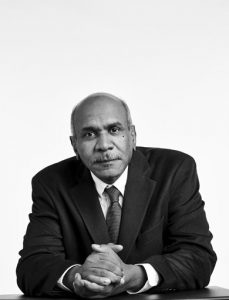
Professor of Hydrology & Climate, MIT
Humans need to keep their core body temperature around 37.5 degrees Celsius (°C) or 99.5 degrees Fahrenheit (°F). As it gets hotter, your body works harder to cool down. When your blood vessels dilate, they lower blood pressure, making the heart work harder to pump blood. If the pressure drops too low, your organs won’t get enough blood, and the risk of heart attacks rises. At the same time, you lose fluids and salts through sweat.
If your temperature keeps rising, you will experience the symptoms of heat exhaustion, including faintness, cramps, and extreme thirst. Long-term exposure to heat stress can lead to kidney stones and heart problems. That’s if you’re lucky. If you can’t cool down at all, you enter heat stroke: confusion, loss of consciousness, organ failure, and death.
If you can’t get out of the heat, sweating is your only lifeline.
Elfatih Eltahir, Professor of Hydrology and Climate at the Massachusetts Institute of Technology, and a global expert in the wet-bulb phenomenon[3], explains it like this:
“We humans are equipped to deal with hot and dry environments, if we have enough water. If you keep hydrating yourself, you sweat, and the sweat evaporates, and that cools your body. […] If you add humidity to that equation, it basically interferes with the natural process by which humans can cope with heat distress.”
How the wet-bulb temperature works
The wet-bulb temperature is an indication of how much the human body can cool itself down by sweating. It is measured by wrapping a thermometer’s bulb in a wet cloth and allowing the water to evaporate naturally. The lowest temperature measured is the wet-bulb temperature.
This temperature is almost always cooler than the temperature recorded by a regular (i.e., dry) thermometer. This is because the bulb is losing heat through the evaporating water: the faster the water evaporates; the lower the thermometer’s temperature will be relative to the air temperature.
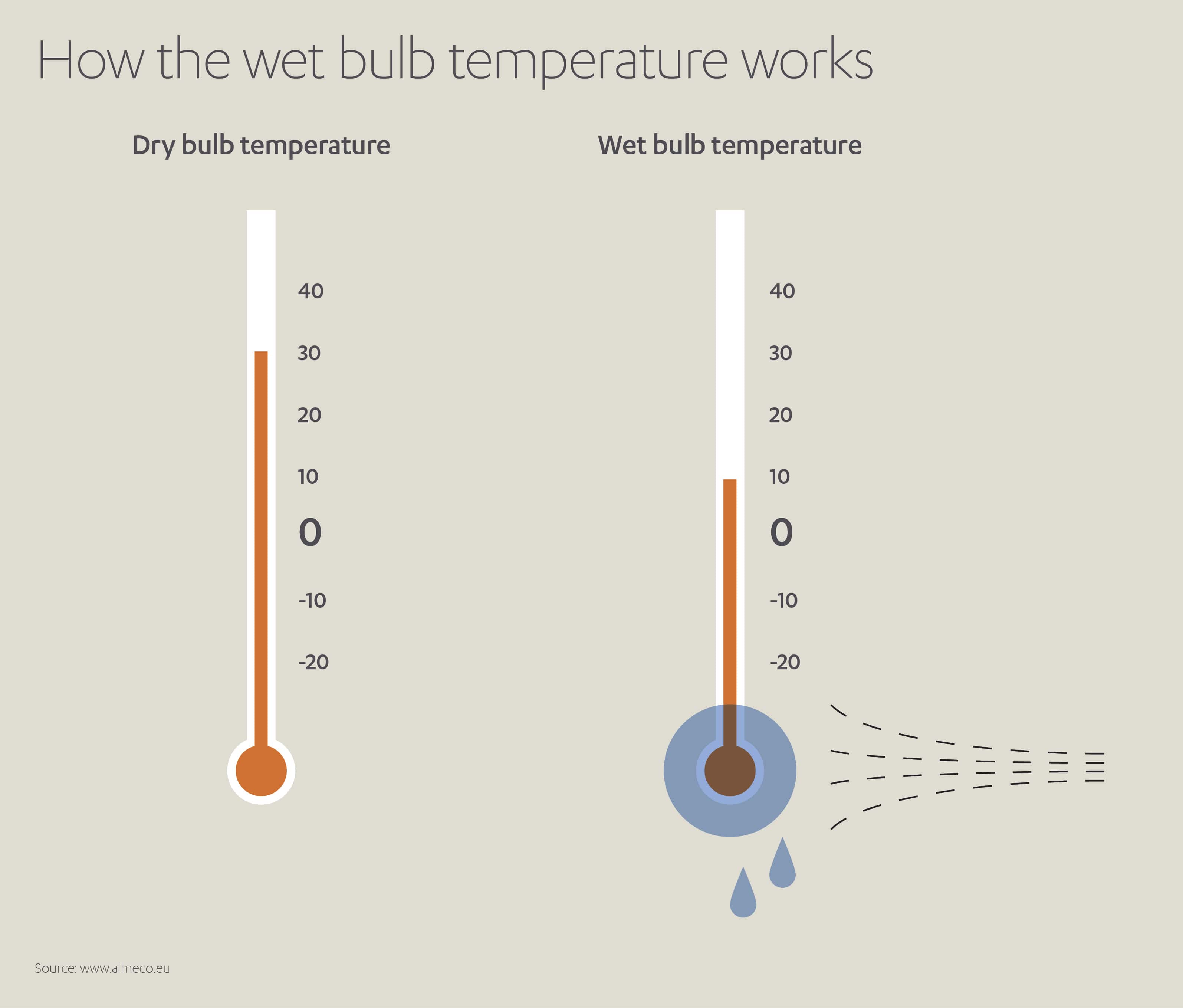
The evaporation rate is directly influenced by the absolute temperature and how much additional moisture the air can hold, known as the relative humidity. Hotter air can absorb more water vapor at a faster rate than cooler air. However, as the air absorbs more water vapor and becomes increasingly humid, there is less room for additional water vapor, and the rate of evaporation slows. Relative humidity of 0% means the air is completely dry. 100% means it can’t get any wetter.
That means no matter how much you sweat, it won’t evaporate.
What’s a dangerous temperature?
This isn’t just interesting science. It’s a life-threatening situation. So much so that in the 1950s, the US military used wet-bulb temperatures (WBT) to devise guidelines for keeping soldiers safe. When the WBT reaches 29°C (84°F), it’s recommended to stop exercising if you’re not acclimatized. Anything above that is classed as an ‘extreme’ danger, and the risk of heatstroke rises dramatically.[4] When the wet-bulb temperature is pushing 35°C (95°F), a healthy person may not be able to survive outdoors for more than six hours.[5]
If the humidity keeps rising, eventually, the wet-bulb temperature will equal the actual temperature. In other words, despite being soaked in water, the wet-bulb won’t cool down at all. And neither would anyone else unlikely enough to still be around.
Humidity makes heat kill faster
If the relative humidity is 100%, there is no way you can cool yourself down by sweating. But it doesn’t have to be that high to spell danger. Similarly, the actual temperature could be over 50°C (122°F), well above the human body’s ideal core temperature, but as long as the air is dry enough, your sweat will evaporate and help to cool you down. It all depends on the relationship between temperature and humidity. The higher the humidity, the lower the actual temperature that can cause health problems (and vice versa).
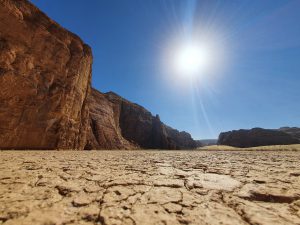
For example, in the context of the Middle East, Riyadh, the capital of Saudi Arabia, is in the middle of the desert. Dubai, in the UAE, is on the Arabian Gulf coast. The temperature in Riyadh is much hotter than the temperature in Dubai, in general. However, the wet-bulb temperature in Dubai is significantly higher than in Riyadh, because Riyadh’s desert air is much drier – and therefore able to absorb more moisture – than coastal Dubai, where the air is already very moisture heavy.
You can sunbathe in higher temperatures than would kill you. For example, if the actual temperature is 32°C (90°F) and the relative humidity is 95%, that’s enough to hit a dangerous 85°F wet-bulb temperature. If the humidity is just 45%, the actual temperature would have to be 40°C (104°F) or more to trigger the same wet-bulb temperature.[6]
Terms like “relative humidity” and “wet-bulb temperature” can seem a little, well, dry. Plus, there are those who say, we’ve survived heat like this before. Why can’t we do it again?
Are we as adaptable as we think?
The truth is that most humans have always lived in regions with temperatures between 6°C (43°F) to 28°C (82°F). This is the sweet spot for human health and food production. But as climate change creates greater extremes of weather, the sweet spot is shrinking. As humans, we are particularly vulnerable because the land is warming faster than the oceans, and most population growth is in already hot regions of Africa and Asia.
A global temperature increase of 3°C will mean the average human is 7.5°C warmer. By the end of the century, around 30% of us will live in extreme heat, defined as an average temperature of 29°C (84°F). On their own, these temperatures are a significant cause for concern. But the wet-bulb temperature is a different beast. As the humidity rises simultaneously, we’ll see more and more days where the wet-bulb temperature exceeds 32°C.
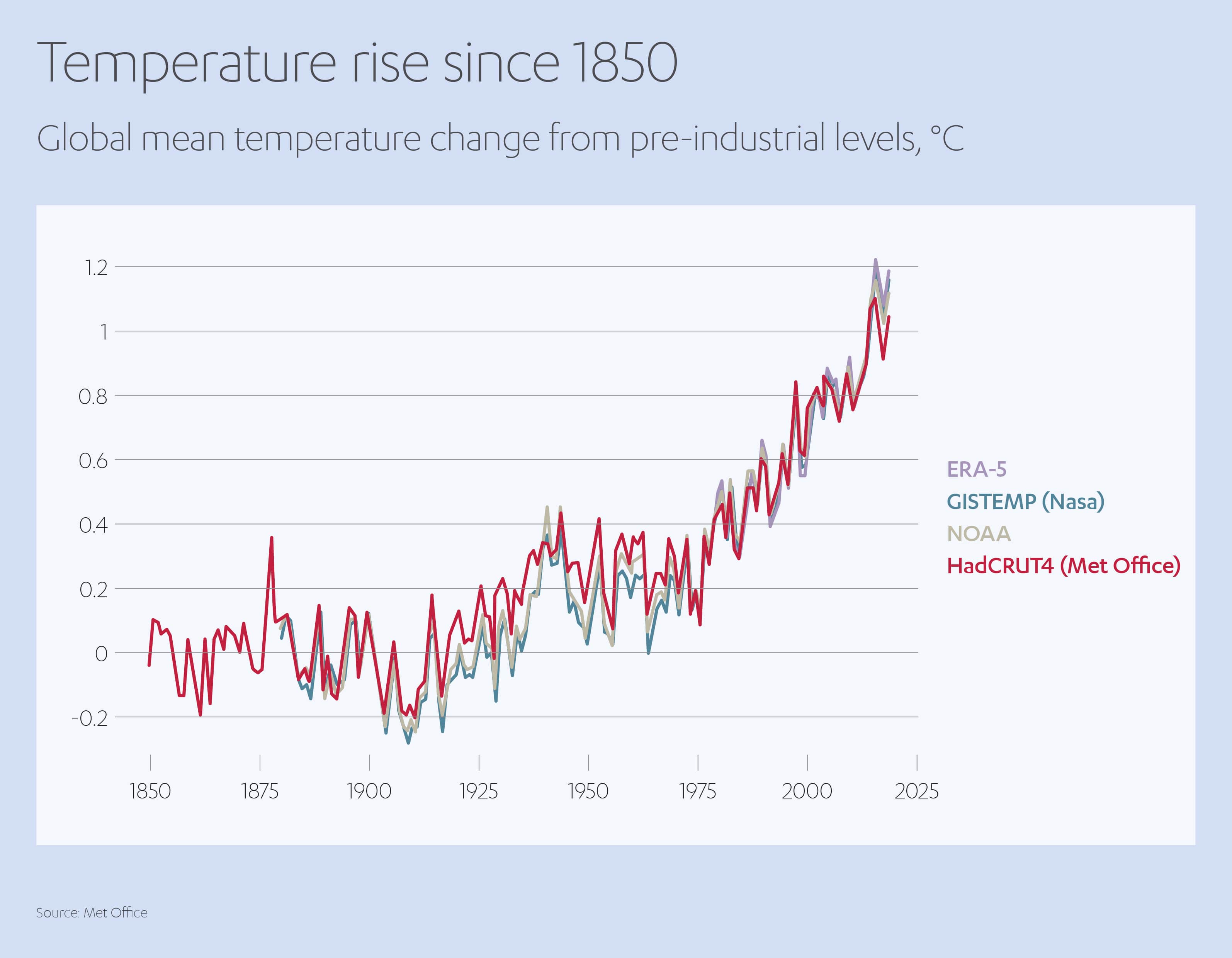
Who is most at risk?
Anyone can be affected by heat, especially as the wet-bulb temperature rises. Some people are more vulnerable than others, though. They include:
- People who can’t take shelter. Anyone working long hours in the heat with outbreaks, from manual laborers and farmers to medical professionals in stuffy protective clothing treating COVID. Some people also avoid drinking enough fluids because they don’t want to go to the toilet during work.
- The old, very young, and those with underlying conditions. Heat stress takes a toll on the body, which is harder to cope with as you age. Similarly, people with conditions like heart disease and diabetes are at particular risk. Diabetes, for instance, can make people lose water faster and reduce their ability to sweat. Children and people with mental health conditions like dementia often need special supervision and assistance to stay cool.
As Marten Scheffer, Professor of Aquatic Ecology and Water Quality Management at Wageningen University in the Netherlands[8], explains, “I think it is fair to say that average temperatures over 29°C are unlivable. You’d have to move or adapt. But there are limits to adaptation. If you have enough money and energy, you can use air conditioning and fly in food, and then you might be OK. But that is not the case for most people.
We think of ourselves as very adaptable because we use clothes, heating, and air conditioning. But, in fact, the vast majority of people live – and have always lived – inside a climate niche that is now moving as never before […] There will be more change in the next 50 years than in the past 6,000 years.”
Rising wet-bulb temperatures threaten the Hajj
The Hajj is the annual pilgrimage to Islam’s holiest city, Mecca, in Saudi Arabia. All the world’s 1.8 billion Muslims are obliged to participate in the Hajj at least once in their lifetime if they are healthy enough and can afford the trip.
The Hajj moves according to the lunar calendar, which means that it occurs at a different time each year. This isn’t a problem during cooler months, but during summer, the heat can be stifling and will only worsen at the current rate of global warming.[7]
The ritual takes about five days to complete, and up to 30 hours must be spent outside. Many pilgrims are elderly, compounding the danger. If conditions continue to worsen, this important event may not be possible for millions of Muslims. Officials already provide cooling for some Hajj participants and have enlarged certain areas to reduce overcrowding. In future years, it may be necessary to strictly limit the number of participants altogether.
There have already been deadly stampedes during the Hajj: one in 1990 killing 1,462 people and another in 2015 that left 769 dead and 934 injured. Both these years coincided with peaks in temperature and humidity. Heat stress could have triggered or contributed to the deadly events.
The next time the Hajj will occur during the hotter summer months will be 2047 to 2052 and 2079 to 2086. The heat will be close to unbearable even if climate change is significantly diminished. And even more dangerous if not.
What will be the worst-hit regions?
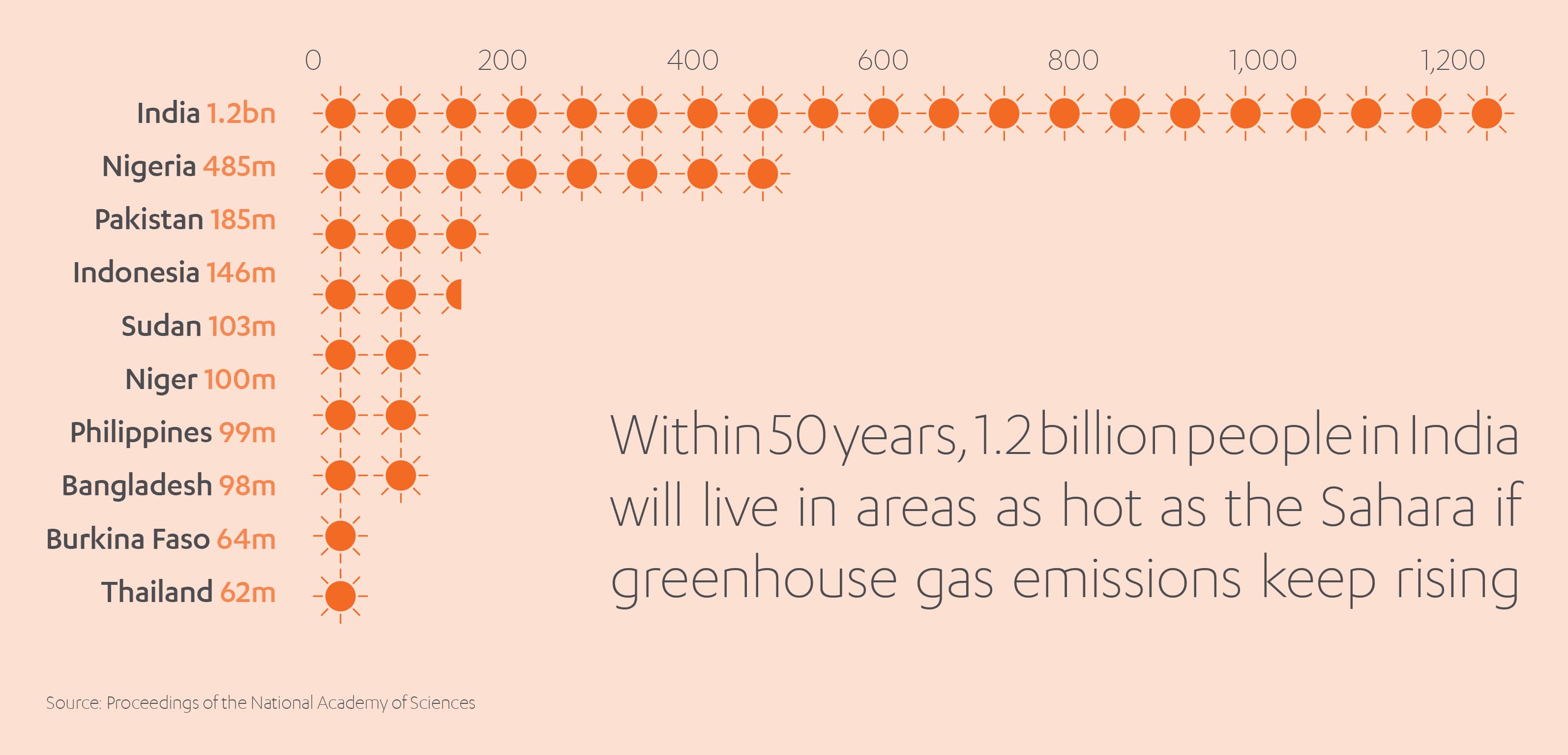
Given the most vulnerable people’s risk profile, those at greatest danger live in warmer, densely populated countries. And, as with much of climate change, that means developing regions will be especially susceptible. The most crucial factor is how many people will be subjected to dangerous wet-bulb temperatures with limited or no access to shelter.
Hotter countries with more affluent populations will be better able to stay cool. For example, the Arabian Gulf is projected to experience some of the highest temperatures anywhere on earth, according to a study from the Massachusetts Institute of Technology (MIT).[9] However, its population is relatively small, has widespread access to air conditioning, and not much agricultural land. Contrast to South Asia, where a significant proportion of the population works in stifling conditions on subsistence farms. India, Bangladesh, and southern Pakistan—home to around 1.5 billion people—will get the worst of the heat.[10] It’s already proving fatal. In 2015, 3,500 people in Pakistan and India died during one of the deadliest heat waves.
To put the pace of change into context, currently, around 2% of Indians sometimes get exposed to 32°C wet-bulb temperatures. By 2100, according to the MIT study, it will be 70%. And around 2% will experience 35°C wet-bulb temperatures – right at the threshold of survivability.
China could be the worst affected
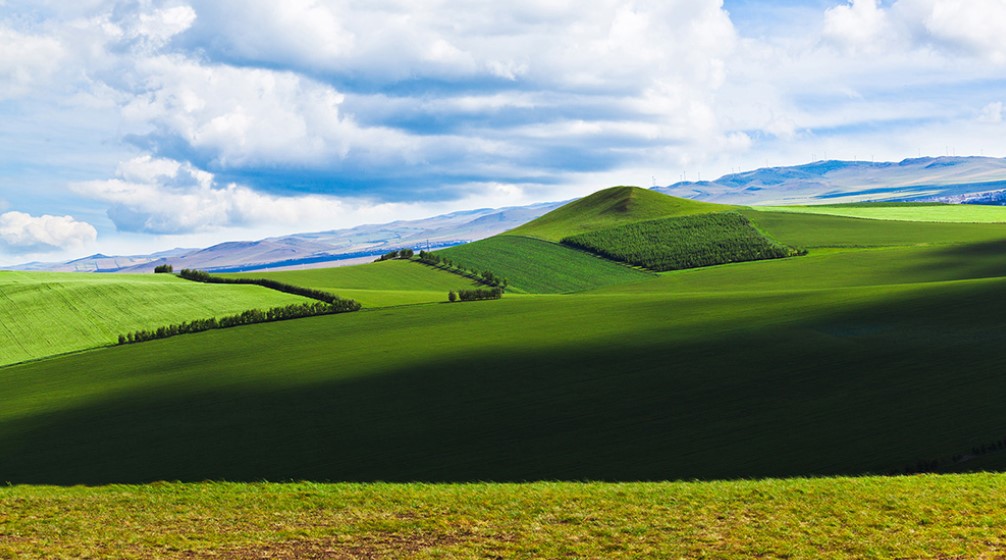
According to another study, the North China Plain (NCP) is at the greatest risk anywhere on earth.[11] This is China’s most agriculturally important region and also its most populous. The area has experienced a significant increase in extreme heatwaves over the last 50 years. In that time, the NCP has warmed almost twice as fast as the global average — 0.24°C per decade versus 0.13°C. In 2013, extreme heatwaves lasted for up to 50 days, with temperatures exceeding 38°C (104°F) in some places. Dozens died in Shanghai, as East China’s largest city witnessed temperatures rise to their highest point in 141-years. At the current global warming rate, even more deadly heatwaves will descend on the region between 2070 and 2100.
The NCP is actually relatively dry. However, intense heat combined with mass irrigation is predicted to raise the relative humidity and trigger dangerous wet-bulb temperatures. Irrigation has a cooling effect at ground level, but its contribution to humidity outweighs it, and water vapor is in itself a potent greenhouse gas. The study reckons that irrigation alone adds an extra half-degree Celsius in warming to the region.
How can we stay cool?
There are well-established strategies for people to mitigate the worst effects of heat in the short-term. When temperatures rise, the most familiar advice includes:
- Drink lots of fluids before work
- Avoid diuretics like tea and coffee
- Rehydrate regularly
- Stay aerobically fit; it increases your heat tolerance
- Beware the signs of heat stress; if you start getting stomach cramps or faint or nauseous, take a break
These measures are easier said than done for many people, particularly for low-income farmers and manual laborers working in the sun all day. That’s why I believe there is an urgent need for governments, public organizations, and businesses to provide additional support, such as:
- Provide water, shelter, and air conditioning
- Prevent people from working when wet-bulb temperatures reach dangerous levels
- Use crowd control
- Build-in low humidity locations, e.g., away from low-lying valleys and warm oceans.
Of course, these measures only treat the symptoms, not the cause.
The real answer is obvious
In reality, the only way to limit the frequency of dangerous wet-bulb temperatures is to reduce global warming, a cause to which I am deeply committed. To do that, we must dramatically reduce greenhouse gas emissions in a coordinated international effort by ramping up renewable power; decarbonizing industry, energy, transport, agriculture, and freshwater production; redesigning our cities and building (or retro-fitting) more energy-efficient buildings to limit heat loss.
It won’t be easy, of course. The technology already exists to a large extent. It’s our commitment that is lacking. Commitment to making a drastic, immediate and irreversible change to our way of life. No single government, country or NGO can do this alone. It requires collaboration, coordination and partnerships at the highest levels of industry, commerce, government and community to drive long-term transformation.
For our part, Abdul Latif Jameel is dedicated to overcoming the challenges that lie ahead, not least through our pioneering projects in solar and wind energy through Fotowatio Renewable Ventures (FRV), and our fast-growing work to addressing water availability, through Almar Water Solutions. We are also working with other leading global private businesses in the Clean, Renewable and Environmental Opportunities Syndicate to help catalyze both business and government investment into solutions to decarbonize industry and combat climate change.
As we begin the process of rebuilding our economies after the global pandemic, we must take the opportunity to act now. To steer a new course towards a more sustainable future. And to stop our society from literally over-heating.
[1] https://www.pnas.org/cgi/doi/10.1073/pnas.1910114117
[2] https://www.carrier.com/carrier/en/worldwide/about/willis-carrier/
[3] https://www.csis.org/podcasts/babel-translating-middle-east/elfatih-eltahir-rising-temperatures-middle-east
[4] https://www.bbc.co.uk/news/science-environment-53415298
[5] https://news.mit.edu/2018/china-could-face-deadly-heat-waves-due-climate-change-0731
[6] https://www.eurekalert.org/pub_releases/2019-08/miot-scc082119.php
[7] Such Kang, Jeremy Pal, Elfatih Eltahir, “Future Heat Stress During Muslim Pilgrimage (Hajj) Projected to Exceed ‘Extreme Danger’ Levels,” Geophysical Research Letters, June 25, 2019.
[8] https://www.theguardian.com/environment/2020/may/05/one-billion-people-will-live-in-insufferable-heat-within-50-years-study
[9] http://news.mit.edu/2015/study-persian-gulf-deadly-heat-1026
[10] Jeremy S. Pal and Elfatih Eltahir, “Future temperature in southwest Asia projected to exceed a threshold for human adaptability,” Nature Climate Change, October 26, 2015.
[11] https://www.nature.com/articles/s41467-018-05252-y.epdf





 1x
1x

 Added to press kit
Added to press kit


